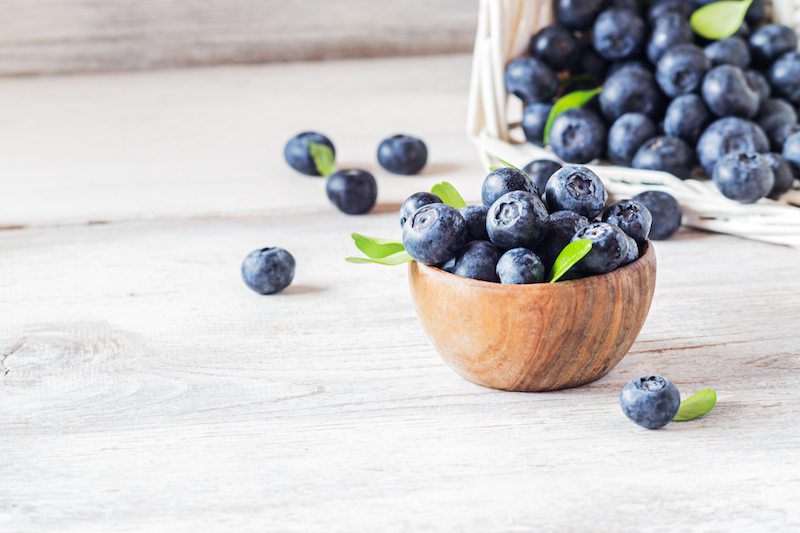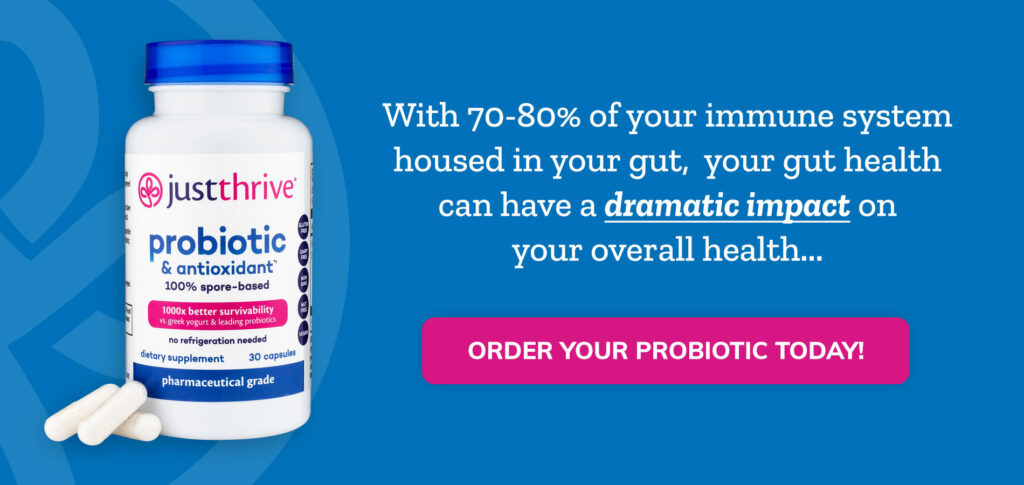Table of Contents[Hide][Show]
What Is a Muffin Top?
A lot of people are all too familiar with the non-food-related version of a “muffin top.” It’s a common scenario: you’re dressed and ready to go, giving yourself that once-over in the mirror before heading out the door.
There’s just one little problem.
Despite the fact that your clothes fit perfectly everywhere else, an annoying roll of flab is rearing its ugly head and spilling over the waistband of your pants. Your muffin top dominates your attention, and you’re convinced everyone else notices it, too.
Many women wonder why these “love handles” show up as they start getting older. Even when you’re managing stress and trying all the best exercises, it’s not uncommon to see extra belly fat growing as the years go by.
The pudge that accumulates around the abdominal area tends to be from visceral fat—the type of fat that surrounds your organs. This specific type of fat is doubly distressing… Apart from being unsightly, it also increases your risk for high blood pressure, insulin resistance, cardiovascular disease, and even dementia.
And the real cause of visceral fat may not be what you think…
It’s All About the Hormones
Even when you’re staying active, it can be hard to avoid the accumulation of visceral fat.
But why? Where does it come from?
In a nutshell, it all comes down to your hormones.
Several different hormones regulate midsection fat, but three particular players tend to rule the game:
- Leptin, when behaving properly, lets your brain know you’ve had enough to eat and decides whether to use food as fuel or store it in your abdomen
- Cortisol, which can feed a muffin top when there’s too much of this stress hormone floating around. When cortisol levels are high, your appetite increases. (NOTE: Belly fat cells contain four times more cortisol receptors compared with other cells!)
- Insulin, which can promote lower back and lower belly fat storage and hikes your risk for metabolic syndrome
What is metabolic syndrome? It is an umbrella term for different risk factors associated with many chronic diseases. These can include obesity, cardiovascular disease, and diabetes.
With elevated insulin levels and cortisol acting like your enemy, that muffin top isn’t going anywhere.
Get Rid of a Muffin Top by Eating These 9 Foods

Before we discuss what foods you should eat to help get rid of that stubborn fat, it’s also important to know what you shouldn’t be noshing on.
Ditching the muffin top includes eliminating the “white stuff”—foods that send insulin levels soaring. These include foods with sugar such as pastries, cookies, cake, bread (especially white bread), rice, and potatoes.
I’m not suggesting you can never eat a sandwich again, but a diet generally high in processed foods, unnatural carbohydrates, and sugar paves the way for midsection fat and increases your risk for disease.
Your fat-loss diet should mainly consist of whole foods such as fruits, veggies, nuts, fish, eggs, and specific types of whole grains. The following are some of the best foods you should consume to break the fat-storing cycle.
1. Wild Salmon
With high-quality lean protein that stabilizes blood sugar and healthy omega-3 fatty acids, wild salmon is helpful for regulating insulin. Human intervention trials also show that supplementing with omega-3 can help reduce visceral fat.
2. Avocado
Rich in healthy monounsaturated fat, potassium, and other nutrients, one cup of avocado also contains 10 grams of filling, fat-busting fiber. A study in the Journal of Clinical Endocrinology and Metabolism found that adolescents who ate more fiber experienced reduced visceral fat and inflammation. Replace olive oil with avocado oil to easily up your avocado intake.
3. Raw Nuts
Loaded with healthy fats, fiber, and protein, raw almonds and other nuts and seeds help stabilize blood sugar and make a delicious snack. Nuts and seeds are also rich in magnesium, a mineral most of us are deficient in.
A study in the journal Magnesium Research found a high-fructose diet with low magnesium levels is a combination that increases inflammation and promotes fat storage in the belly.
4. Green Tea
Dump the cortisol-raising java for a healthy cup of green tea. Numerous studies show that the catechins (antioxidants) in green tea help reduce body fat.
In addition to revving your metabolism, green tea can also block the formation of new fat cells. One study found that men who drank green tea lost twice as much weight as a placebo group and four times as much belly fat over the course of three months.
5. Blueberry
A University of Michigan study found obese rats had lower visceral fat triglycerides and improved insulin sensitivity after eating a blueberry-enriched powder for 90 days. Blueberries add real fiber and a phytonutrient punch to any meal, and frozen blueberries can be just as effective as fresh ones when it comes to boosting fat and weight loss.
You can snack on blueberries on their own or add them to smoothie bowls, oatmeal, or chia pudding.
6. Eggs
Eggs are high-protein foods with very low calories, so you can eat up to three of them a day without a problem (as long as you’re within a healthy cholesterol range as eggs can slightly raise blood cholesterol). They are high in satiety index, which makes them an excellent breakfast meal.
A 2002 study further revealed high-protein diets, such as those with eggs, can also help fat loss through their thermogenic effect. This means you can sit in front of your PC and still burn more fat than those on a low-fat, high-carb diet.
If you find the taste of eggs lacking, you can add more fats by making it sunny side up with coconut oil or scrambled eggs with grass-fed butter. Note, though, adding these can also increase the food’s calorie count.
Related
Skipping Breakfast and Weight Gain
Ever wake up in the morning too rushed to eat? You might want to set your alarm back. Studies say skipping breakfast is linked to weight gain.
7. Quinoa
A lot of people wear themselves ragged via a cardio workout, high-intensity interval training (HIIT), aerobics, or other full-body workouts . . . all to no avail. HIIT workouts and other exercises that get your heart rate up are great for burning fat when coupled with a healthy diet, but if you can’t quit refined grains and wheat then you’re fighting a losing battle.
If this is you, then quinoa makes an excellent substitute, especially for those who choose a gluten-free lifestyle. This whole grain is high in protein and fiber but low in sugar or glycemic index.
It also contains an amino acid called betaine. This amino acid can lower the levels of homocysteine, which studies associate with an increased risk of heart disease.
It converts homocysteine into a type of methionine, which is essential in improving liver function. The liver plays a significant role in reducing the appearance of a muffin top by regulating fat storage, among others.
Other studies suggest betaine may encourage the growth of muscle mass, which can help you get rid of the subcutaneous fat. Quinoa is also great to eat if you are doing interval training exercises, as its many macronutrients help with muscle repair post-workout.
8. Banana
If you love baking, you can combine baking soda and baking powder with some mashed banana as a substitute for brown sugar. Both are sweet, but the fruit can have lower calories.
Bananas do have sugar, but their glycemic index is in the low to medium range. Bonus: They don’t cause significant glucose spikes.
Unripe bananas have high levels of resistant starch, which is a complex chain of sugar the body cannot digest. What does this mean for you if you’re trying to shed your muffin top? This makes the fruit a form of soluble fiber, slowing down the absorption of glucose. A 2015 study revealed that resistant starch can also enhance fat oxidation (fat burning), especially when paired with protein.
9. Greens
You can also lose belly fat by eating your greens, such as kale, spinach, and broccoli. These foods contain massive loads of vitamins and antioxidants, which can reduce chronic inflammation.
A 2007 study cited a link between abdominal fat formation and chronic inflammation. The latter can increase the chances of metabolic syndrome.
Greens are also filling but low in calories, so you can add them to your favorite foods to make the meals healthier.
You can also make them into smoothies and combine an Alkalizing Greens powder with equally nutritious fat-burning foods such as blueberries and bananas.
Change Your Diet to Prevent Health Risks
It’s unwise to underestimate the dangers of visceral belly fat. It won’t just affect your waist but also other parts of the body such as your hips, knees, and feet.
And as we’ve seen, you run the risk of damaging internal organs such as the liver and pancreas. The fat can accumulate around them and secrete its own hormones.
Some people rely only on specific exercises for the belly coupled with strength training to help lose muffin tops. Others succeed especially when they learn to target certain muscle groups—like the lower abs—to build lean muscle or when they work with the right personal trainer.
In many cases, however, they gain back all the weight they lost simply because of poor dieting habits.
So while it may seem frustrating that you can’t melt away that excess fat with good old-fashioned sit-ups or dumbbells all on their own, know that your diet and hormones are the true gatekeepers to a flat belly. Turn to the fat-busting foods listed above, and you’ll send the muffin top packing in no time.
It’s also a good idea to seek medical advice from your primary care physician before making a big change to your diet or exercise regime. Getting a physical to understand any underlying risk factors and your baseline starting position is a great idea to help chart your progress.
You May Also Like…
Editor’s Note: This post was originally published on October 17, 2015, and has been updated for quality and relevancy most recently on March 24, 2021.






